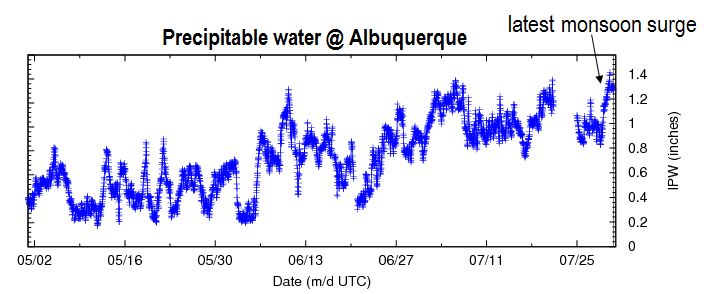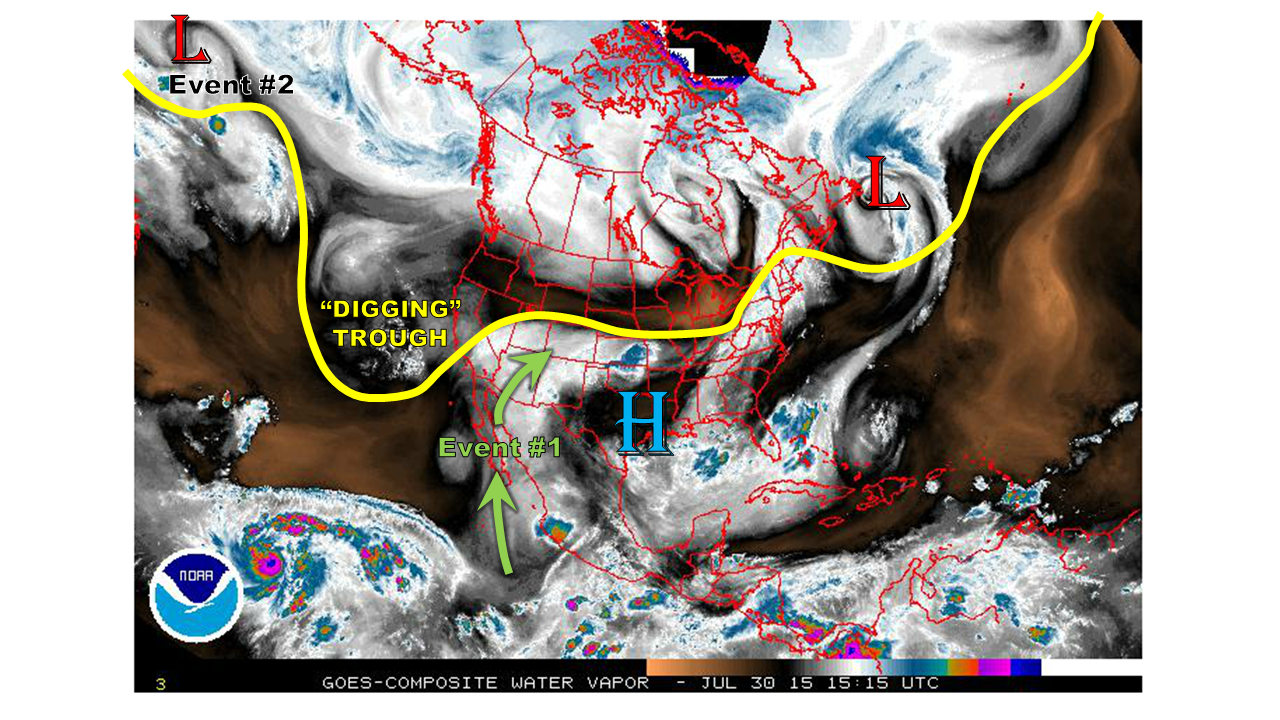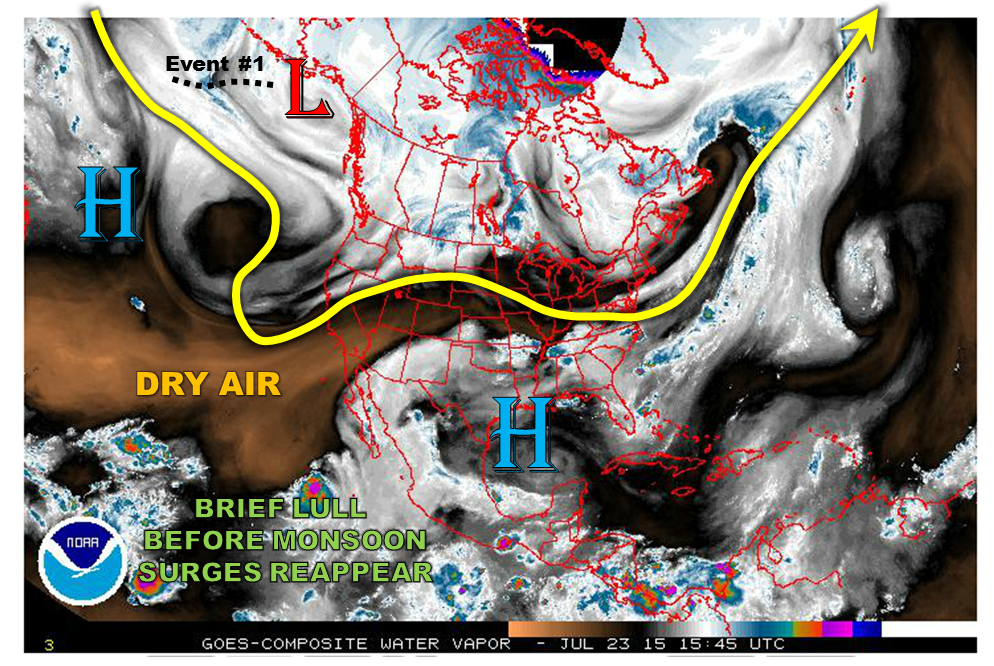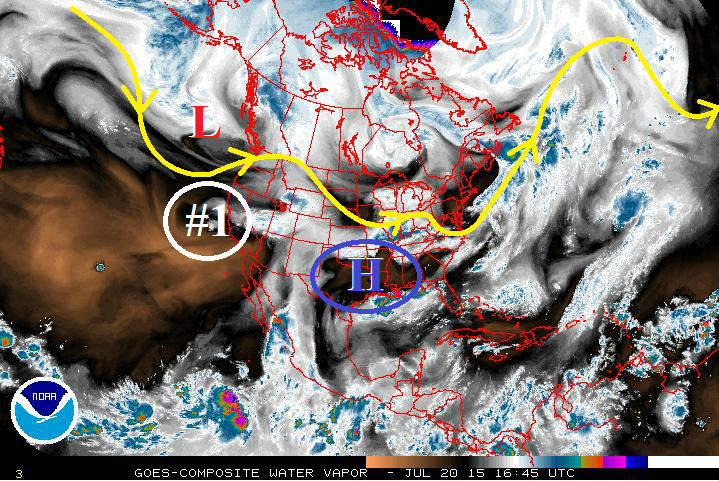Issue Date: 7/30/2015
Issue Time: 2:30PM
Valid dates: 7/31 – 8/14
Overview 
Moisture. That is quite possibly the single most important variable in the equation for heavy rainfall across Colorado during the summer. If it is present, even benign conditions, such as strong solar heating, can cause thunderstorm activity. If it is not present, even a strong atmospheric disturbance can end up producing storms with gusty winds, but only a few raindrops. This summer, moisture has seemingly been in never-ending supply. A few weeks ago, we published this Twitter post showing that it has been the most humid summer in Denver since at least 1961:
Think it’s been humid this spring/summer? You are correct. Most humid May/June at Denver since at least 1961! #COwx pic.twitter.com/a0wJnmnOUD
— CO Flood Updates (@COFloodUpdates) July 10, 2015
Fast forward to today, and we have continued to see a very humid summer in Colorado, with almost daily thunderstorm activity at least somewhere across the state.
For this Flood Threat Outlook, all indications point to a continuation of active weather across Colorado. In particular, we anticipate two separate heavy rainfall periods over the next 15 days. Now on to the details. The water vapor image, below, shows a disturbance positioned off the California coast. Instead of following a typical eastward movement, this disturbance will actually move south, or “dig” deeper into the subtropics. To its east, we see a return flow of subtropical monsoonal moisture that is currently providing active weather from Southern California all the way to New Mexico.
This latest push of subtropical moisture is some of the highest of the season, as is seen by looking at the Precipitable Water chart for Albuquerque, NM since May 1st. Note that values have recently been in the 1.3 to 1.4 inch range, which is in the 98th percentile based on the region’s climatology. As the aforementioned trough digs deeper, moisture will continue to trickle into the four corners region. This will support a prolonged 4 day period of wet weather, mainly across southwest Colorado (Event #1). After Event #1, there will be a lull, as the monsoon connection is severed for a few days. But by late next week, another period of unsettled weather will start as a disturbance currently in the west Pacific migrates towards Colorado (Event #2). It appears that this event may be focused east of the Divide. Looking out past Event #2, there are indications of more active weather. However, at this time, we cannot confidently pinpoint the timeframe, or region most under threat. We will reinvestigate these details during the next update of the Flood Threat Outlook on Monday, 8/3. Stay tuned.
As the aforementioned trough digs deeper, moisture will continue to trickle into the four corners region. This will support a prolonged 4 day period of wet weather, mainly across southwest Colorado (Event #1). After Event #1, there will be a lull, as the monsoon connection is severed for a few days. But by late next week, another period of unsettled weather will start as a disturbance currently in the west Pacific migrates towards Colorado (Event #2). It appears that this event may be focused east of the Divide. Looking out past Event #2, there are indications of more active weather. However, at this time, we cannot confidently pinpoint the timeframe, or region most under threat. We will reinvestigate these details during the next update of the Flood Threat Outlook on Monday, 8/3. Stay tuned.
Now we look at the details of the two flood threat Events:
Event #1: Friday (7/31) – Monday (8/3)
An Elevated flood threat as a stubborn plume of subtropical moisture impacts mainly southwest CO
The digging disturbance off the California coast will send moisture into southwest Colorado, resulting in daily afternoon and evening thunderstorm activity. The region under the highest threat is the San Juan mountains, where upslope flow will result in heavy rainfall threat every day. Over the entire period, over 2 inches of rainfall can be anticipated for localized areas of the San Juans, with lesser totals to the north and even as far eastward as the Southeast Plains. In addition to an elevated flash flooding risk, isolated mud flows and debris slides can be anticipated with this event.
Event #2: Thursday (8/6) through Saturday (8/8)
An Elevated flood threat, mainly east of the Divide
A disturbance will trek all the way across the Pacific Ocean (see water vapor image) and impact Colorado by later next week. As this disturbance will likely be coming in from the west/northwest, it appears that the monsoonal connection may be limited. We anticipate that the Northeast Plains will be under the highest threat for heavy rainfall as a cool front makes its way down the east face of the Rockies, promoting easterly upslope flow. In additional to the rainfall threat, since this disturbance will be accompanied by jet stream dynamics, hail and strong winds may be possible. At this time it appears that the disturbance will keep moving east. However, it is possible, that the cool front will sag all the way into southeast Colorado, which will increase rainfall chances there too. We anticipate to have a much better grasp on this setup in the Flood Threat Outlook, on Monday 8/3.






